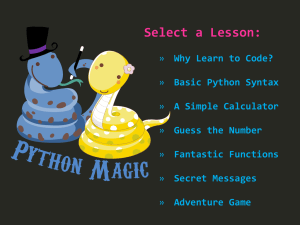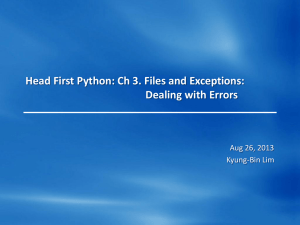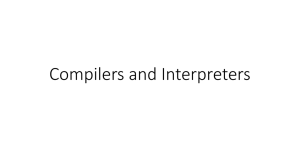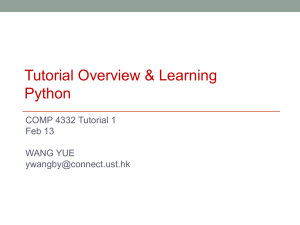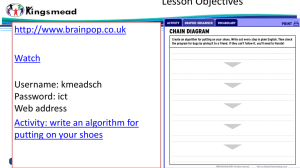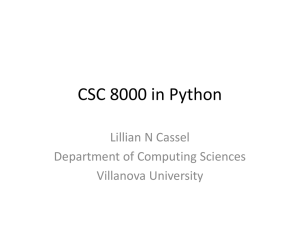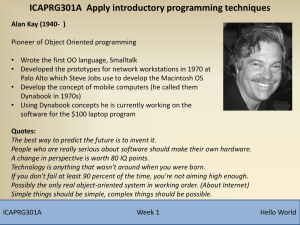Lecture 1
advertisement
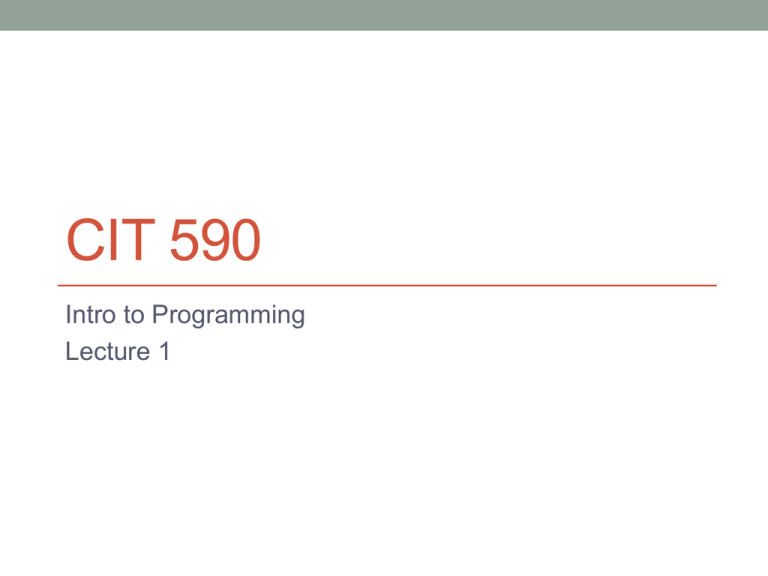
CIT 590 Intro to Programming Lecture 1 By way of introduction … • Arvind Bhusnurmath • There are no bonus points for pronouncing my last name correctly • Please call me Arvind. I am pretty informal. • Graduated 2008 from Penn • Ex GRASPee – thesis on convex optimization in computer vision • Worked in Software for 5 years – APT • www.predictivetechnologies.com Who is this course for? • non CS majors • People who want to learn the basics of programming and have never programmed before • People who have programmed before but have not used that skill in a long time Who should not take the course • If you have written a project in any programming language • Programming languages come and go, you do not need to take a course just to learn a new language • People who have a lot of other coursework • This course will require a time commitment • Programming assignments every week – most of them are not super easy • People who want to work alone • Pair programming is an essential part of the course • If you drop/waive the course, people on the waiting list will be very happy. Contents of the course • 50% Python and 50% Java • Why begin with Python? • Easier language to pick up • you can spend more time thinking about programming logic and algorithms, and less time thinking about correct syntax • Interpreted language (more on that in a bit) • An actual commercially used language in places like Google, Youtube • most of the lines of code for YouTube are still in Python. Everytime you watch a YouTube video you are executing a bunch of Python code. • Why transition to Java? • Object oriented programming (the cool prevalent paradigm) • Used in many many applications • Android applications are in Java • Higher chances of getting a job Keeping track of CIT590 • http://www.seas.upenn.edu/~bhusnur4/cit590_spring2014/ schedule.html • If you are curious and want to read ahead • http://www.seas.upenn.edu/~bhusnur4/cit590_fall2013/schedule.ht ml • Go to http://www.seas.upenn.edu/~bhusnur4/cit590_spring2014/ staff.html for office hours • Piazza will be used for class discussion and clarifications – please use it heavily! Resources for Python • Exploring Python by Timothy Budd • Use this book as an active participant. Read it with a computer in front of you and typing things out as you go along. • Highly highly recommend buying this book. • Byte of Python – free e-book that you can download and carry around as a handy reference • https://github.com/abhusnurmath/rando/tree/master/cit590 Examples • Contains a bunch of examples from the previous course • Caution: some might not be relevant so please follow along in class Exams, homeworks etc • Homework every week. Deadlines will be strictly enforced. • If you do have an emergency, send me email or have one of your classmates send me email • Homework will be worth 45% of the grade • Mid term 20% • Final exam 25% • Class participation 10% Class participation? • Lab (recitation) attendance is mandatory! • If you have a reason to miss it, please inform me at least a day in advance • ‘I have an on-site interview’ is a valid excuse only if you tell me which company and provide some evidence of the invite • Be a nice partner! • We had some horror stories last semester • One question on your final exam will be who was your best and worst partner • Ask questions on Piazza • http://piazza.com/upenn/spring2014/cit590 • Sign up and ask questions • I really want to promote discussion • Ask questions in class • Tougher to keep track of who asked what Lectures and labs • 2 lectures and 1 lab every week • We will cover a mix of syntactic aspects as well as elements of programming style • Encouraged to bring laptops to class to follow along • If you spend time playing candy crush … oh well • Tough to wait until every one has managed to run their program so slides being used How to turn in assignments • Canvas • Assignments will be due on Friday mornings • Essentially think of Thursday midnight as your deadline Requisite slide about plagiarism and cheating DON’T CHEAT!! Python • Created by Guido Van Rossum. • Actually named after Monty Python and not after animals that squeeze their prey to death Python • Interpreted language • No compilation • If you’ve seen matlab or R this paradigm will look familiar • There is no intermediate stage when you run the program • This does mean that sometimes it is hard to figure out mistakes in a program Python config • Use python 2 and not python 3 • http://www.python.org/download/releases/2.7/ • We will try to stick to the IDLE for editing • Remember to save your file as xyz.py before beginning to edit • Other options for editing a python file (I will stick to using IDLE) • Vim/vi • Emacs • Notepad++ • Sublime text • Eclipse with PyDev Python demo • IDLE • Throwing commands into the shell • Configuring IDLE • More on this in the lab session • Data types • Integers • Float • Boolean • 5/2 is not 2.5. However both 5.0/2.0, 5/2.0 are • Strings – single, double and triple quotes • There are tons of operators. Please spend some time experimenting with them • Do not worry about the bit shift operators for now • http://www.tutorialspoint.com/python/python_basic_operators.htm • Do not worry about making mistakes. ‘With every mistake we must surely be learning’ – George Harrison Variables in python • Variables are used to keep track of information within a program • An assignment statement is of the form Variable name = value • Proper naming of variables is important. • Variables that store the first, second and third highest scores in a test • a, b, c = bad • first, second, third = better • Randomly named variables will result in loss of points in assignments • You cannot use space, but can choose between second_best or secondBest(camel casing) • “ Programs must be written for people to read, and only incidentally for machines to execute. ” - Abelson Strings • Strings are basically just collections of characters • Can be indexed • Always remember 0 indexing • Strings are immutable • Once a string is assigned to a variable, you cannot mess around with the characters within the string Operators • Experiment with operators in class to see • ** used for power operation • // used for divide and floor • simpleMath.py Functions in python • Similar to the math concept of functions • Functions on strings • Functions that convert from one data type to another • The fun ‘eval’ function • Input and output functions • Raw_input – to read in string input • Print – to print out something • Input – to read in an integer or float Writing a program • A sequence of statements that will be executed one by one • Remember to save your file with the extension “.py” • tempConv.py Example program • Temperature converter example from the book • Testing! • No code is complete until tested • In the industry, there are entire jobs associated with testing Assignment statement • • • • • Python has a very flexible assignment syntax area = length * breadth counter1 = counter2 = 0 area, perimeter = length * breadth, 2 * (length + breadth) x, y = y, x • Extremely elegant way to swap the values of two variables Reading input from a user • To read an integer the syntax is • I = input(“enter an integer”) • The “enter an integer” portion is called the prompt and it can be any string • Quick tip – Use “\n” if you want to move to the next line in a prompt • I = input(“enter an integer\n”) Conditionals • If • Syntax is if <boolean-condition>: • If, else and the importance of proper indentation • Python does not have open braces or anything like that to indicate code blocks! • Everything is about indentation • The elif • Example program guessingGame_v1 While loops • Repeated execution of a task is done via a loop • Example program multiplicationTable.py • Infinite loops • CTRL + C is your best friend it will pause execution • Good rule for while loops • Write some kind of incrementer/decrementer down ASAP • Make sure the program can exit the loop regardless of whether the task is accomplished or not • An infinite loop is an example of what is called a “bug” • A bug can be a syntax error (easily detectable and hence very rare these days) • A line of code that has an undesirable effect is also a bug For loop • When we have an arithmetic progression • for x in range(0,10): • Includes the 0, does not include the 10! • for x in range(0,10,2): • When we are looping through characters in a string • for letter in ‘bhusnurmath’: Example program in Python • For loop • Conditionals • beer.py


